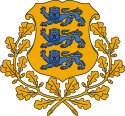Prime Minister of Estonia
| Prime Minister of the Republic of Estonia Eesti Vabariigi peaminister |
|
|---|---|

|
|
| Residence | Stenbock House, Tallinn |
| Appointer | President of Estonia |
| Term length | General elections to the Riigikogu are held every four years at most. The Prime Minister is by convention the leader of the victorious party. No term limits are imposed on the office. |
| Inaugural holder | Konstantin Päts |
| Formation | 24 February 1918 |
| Website | http://valitsus.ee/ |
The Prime Minister of Estonia (Estonian: Eesti Vabariigi peaminister, literally translated as Head Minister of Estonia) is the head of government of the Republic of Estonia. The prime minister is nominated by the President after appropriate consultations with the parliamentary factions and confirmed by the Parliament. In case of disagreement, the Parliament can reject the President's nomination and choose their own candidate. The Prime Minister is usually the leader of the largest party in the ruling coalition. The current Prime Minister is Jüri Ratas of the Centre Party.
In his role as appointed by the President and laid forth in the Constitution, the Prime Minister serves as the head of government. He does not head any specific ministry, but is, in accordance with the constitution, the supervisor of the work of the government. The Prime Minister’s significance and role in the government and his relations with other ministries often depend on the position of the party led by the prime minister in vis-à-vis the coalition partners, and on how much influence the prime minister possesses within his own party. If the prime minister has a strong position within his party, and the government is made up solely of representatives of that party, he can enjoy considerable authority. In all crucial national questions, however, the final word rests with Riigikogu as the legislative power.
Estonia was governed by a Prime Minister during the first two years (1918–1920) of its independence after the collapse of the Russian Empire.
Under Estonia's 1920 constitution, the head of government was called the State Elder (riigivanem), who was also head of state. This system was a radically parliamentary system because the State Elder could be dismissed by the Parliament with a simple majority. Moreover, the State Elder was not the commander-in-chief of the armed forces, nor could he ratify laws or dissolve Parliament. The dissolution of Parliament was only possible through a referendum (see, for example, Seppo Zetterberg, "A History of Estonia" / Viron historia. 3rd edition. Helsinki: The Finnish Literary Society / Suomalaisen Kirjallisuuden Seura, 2007, pages 524–525). Under a new constitution passed by plebiscite in 1933, the position of Prime Minister was recreated as head of government in 1934 in a more presidential system. Under this constitution, the President could appoint and dismiss the Prime Minister and Cabinet, veto laws, give decrees (statutes) and dissolve Parliament (see Zetterberg 2007, pages 558–559). The sitting State Elder, Konstantin Päts, appointed himself to the position of Prime Minister and in this position was then able to suspend elections for Elder of State and for the Estonian Parliament. He remained Prime Minister, declaring himself "President-Regent", until 1938, when elections were held under a new constitution and he was elected President.
...
Wikipedia

